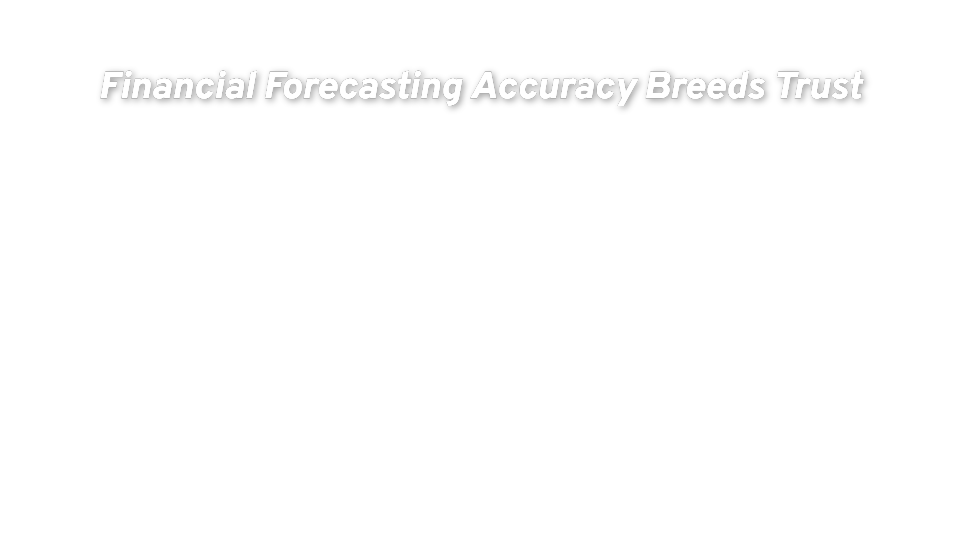Financial forecasting plays a pivotal role in positioning a company for growth and sustainability.
But these forward-thinking analyses can quickly crumble as a result of the slightest misstep in approach or execution, threatening the credibility of the finance team and the overall success of the company.
On a macro level, many issues stem from a disconnect between the finance function and the business itself.
Relationships and communication can be as critical as data and equations to the ultimate accuracy of a forecast.


We cannot forget that understanding how and why a business operates is part of the finance team’s responsibility, and the best way to develop that understanding is by creating and leveraging strong partnerships with the other internal stakeholders responsible for those operations.
With that level of trust and insight in place, you can contextualize your data analysis and scenario testing to yield results truer to your company’s current and future state.
Here are 10 common forecasting mistakes I’ve seen throughout my time in financial planning, and more importantly, some tips to avoid them.
Mistakes in Overall Financial Forecasting Approach
1. Leveraging for Cost Cutting
Creating an annual budget is one of the primary objectives of forecasting, which leads to one of the most common mistakes.
Asking someone to build a budget by starting with cutting costs makes sense on the surface, right? When you reduce expenses, you show higher net income.
But a forecasting approach that leads with cost-cutting efforts creates adversarial relationships and a combative environment.
You’re asking business partners, who are often experienced professionals, to defend the expenses they’ve deemed necessary. Not only do you pull the plug on their enthusiasm and lose engagement, you may encourage gaming and manipulation in order to align with your goals. Ultimately, the approach leads to forecasting inaccuracies and foul relationships.
If you do need to cut costs, establish partnerships with business owners and create shared accountability, so, together, you work toward the goals that will best impact your organization’s performance.
2. Limiting Your Focus to Incremental Change
When you look specifically at spending or revenue opportunities – examining where you can save or spend a dollar – you miss opportunities for more impactful improvement.
A better approach to forecasting is to take a step back and look at the bigger picture. Ask yourself how you can think differently today to better influence tomorrow’s outcomes.
Think of it as you would a personal budget. Rather than considering how to trim your electric bill to cut your monthly expenses, go bigger. Consider your overall lifestyle and how you can adjust it to help you reach the goals you have defined.
3. Sticking to Singular Ownership
There is often debate over who holds accountability for financial results in an organization. Whether you rely on a centralized approach, where Finance owns forecasting and project expectations throughout your organization, and therefore results, or a decentralized approach, where accountability is distributed to the business, you’re likely to miss the mark.
It’s here that the power of partnership, again, comes into play.
Creating shared accountability for results gives business partners full accountability for the activities that drive their budgets, and better participation in the creation of a forecast. Through a strong partnership, finance professionals can understand what drives outcomes and are equally held accountable for meeting those goals.
Tactical Errors in Financial Forecasting
4. Leveraging a Single Dimension
Many forecasters focus on what they see as the most dominant driver of their business, perhaps revenue from a core product or service, and create models that solve for the best possible outcomes for that primary driver. But the past doesn’t always predict the future.
There are multiple dimensions that drive revenue and costs, and focusing solely on a driver that has historically performed well exposes you to vulnerabilities.
What happens, for instance, when your sales organization shifts its focus to another market or product? Your driver will perform far differently than anticipated.
To avoid being misled on your forecast, consider a multi-dimensional view of your business, ensuring that you include lower priority drivers and factor in the many variables that could affect their performance.
5. Going Too Deep for Too Long
We financial folks love to admire a good problem, don’t we?
Sometimes forecasters can get stuck in the weeds admiring the intricacies of a complex financial problem and lose themselves overanalyzing it. And while analysis paralysis is not unique to forecasting, it can end up causing greater damage than many other areas of business when the value of the solution we’re supposed to provide is lost because it’s taking too long to get to it.
You can provide real value by determining outcomes and articulating insights that business partners can understand and leverage to improve the business. Prompt delivery is as essential as the insights you provide.
As General S. Patton said, “A good plan violently executed right now is far better than a perfect plan executed next week.”
6. Depending on a Trend That’s Too High Level
Trend forecasting is useful, but banking on it can be detrimental to your success.
For instance, you may look at your organization’s sales production to revenue and see a tight connection between the two. However, there are other drivers – maybe interest rate or yield – that may also be driving that result and are easy to overlook.
Remember to keep in mind the forest as you’re looking through the trees and take into consideration the multitude of factors that could be contributing to the results you see.
7. Forecasting to the Goal
Your forecast can be impressively accurate. But things change.
Regardless of the change, people are held accountable to an original goal, so they try to find ways to get back to that goal without changing their behaviors. And when they do, they create a false sense of confidence. Everyone thinks they are ok, and they aren’t.
Instead of continuing the course when the unexpected happens, figure out what went wrong and what needs to change. Then alter the underlying dynamics to improve your ability to influence the values that drive the outcomes you desire.
8. Relying Too Heavily on a Forecasting Model
Most businesses depend on quantitative forecasting models. Financial forecasting models are powerful tools, but they are often predicated on historical data. And, as we said, things change.
When you are hyper-focused on a model that doesn’t take into consideration variables that can have a marked impact on outcomes, you’ll inevitably miss your target.
So, how do you keep an eye on the variables that threaten to throw you off course?
Rely on those communicative relationships. Relationships between business operators and the operators of models are essential to accurate forecasting.
Forecasting in a vacuum won’t do anyone any good, but staying involved with your business leaders will help ensure you’re forecasting within the context of the business itself.
Financial Forecasting Mistakes Specific to Staffing
9. Over-Relying on Staffing Trends
Staffing trend analysis is helpful in predicting the company’s future employment needs, yet forecasting based solely on those trends is like operating with blinders on.
You need to look at the many factors business operators consider to make their staffing more efficient, including process changes, new technologies and tools, and education.
If you ignore these efficiencies and look only at the people-to-cost metrics your model provides, you’ll be off the mark.
Instead, focus on the behaviors that are driving your staffing model, not the historical trends.
10. Aligning with the Growth Plan
Growth plans are typically optimistic. Forecasts should be realistic.
Optimistic sales professionals and entrepreneurs aim high when anticipating their staffing needs, and it’s not uncommon for them to forecast people needs in excess of those required to meet their goals. This alignment is critical. Further, it is common to fail to accurately account for the time and costs associated with recruiting and hiring.
According to a recent AvidXchange study, the average time to hire from contract to start date is 56 days. So, when business leaders are anticipating making hires in September, there’s a good chance you won’t start paying those new employees until November.
Attrition is another reality that isn’t taken into those people leader projections but absolutely impacts forecasting accuracy. Every company has some level of regular attrition, and even though managers may not account for that reality, finance professionals should.
Keep those staffing truths and timelines top of mind to give yourself the best chance at an accurate forecast.
Conclusion: Financial Acumen and Strong Partnerships Lead to More Accurate Forecasting
Creating an accurate financial forecast enables you to influence the course of your organization, set direction and optimally allocate resources.
Success is undoubtedly dependent on you getting it right.
By avoiding common mistakes, you can consistently meet or even exceed expectations, increasing your team’s credibility and, hopefully, the business’s bottom line.






